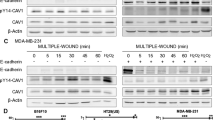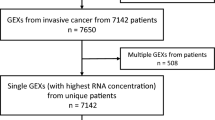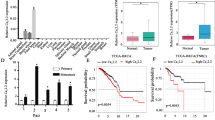Abstract
Caveolin-1 was identified in a screen for genes involved in breast cancer progression. Caveolin-1 is the major protein component of caveolae, flask-shaped invaginations found in a number of different cell types. Using an orthotopic model of spontaneous breast cancer metastasis, caveolin-1 was found to be expressed in low and non-metastatic primary tumors, but at much lower levels in highly metastatic 4T1.2 and 4T1.13 tumors. Exogenous expression of caveolin-1 at moderate levels in 4T1.2 cells was sufficient to suppress primary tumor growth after inoculation of cells into the mammary gland. Expression of high levels of caveolin-1 also inhibited subsequent metastasis to distant organs. Cells expressing high levels of caveolin-1 showed reduced capacity to invade Matrigel, diminished response to laminin-1 stimulation and decreased metastasis to lung and bone. This study provides the first functional evidence that caveolin-1 regulates primary breast tumor growth and spontaneous metastasis of breast cancer.
This is a preview of subscription content, access via your institution
Access options
Subscribe to this journal
Receive 50 print issues and online access
$259.00 per year
only $5.18 per issue
Buy this article
- Purchase on Springer Link
- Instant access to full article PDF
Prices may be subject to local taxes which are calculated during checkout




Similar content being viewed by others
References
Aslakson CJ and Miller FR . (1992). Cancer Res., 52, 1399–1405.
Bender FC, Reymond MA, Bron C and Quest AF . (2000). Cancer Res., 60, 5870–5878.
Engelman JA, Zhang XL and Lisanti MP . (1999). FEBS Lett., 448, 221–230.
Fiucci G, Ravid D, Reich R and Liscovitch M . (2002). Oncogene, 21, 2365–2375.
Garcia-Cardena G, Martasek P, Masters BS, Skidd PM, Couet J, Li S, Lisanti MP and Sessa WC . (1997). J. Biol. Chem., 272, 25437–25440.
Giancotti FG and Ruoslahti E . (1999). Science, 285, 1028–1032.
Hayashi K, Matsuda S, Machida K, Yamamoto T, Fukuda Y, Nimura Y, Hayakawa T and Hamaguchi M . (2001). Cancer Res., 61, 2361–2364.
Ho CC, Huang PH, Huang HY, Chen YH, Yang PC and Hsu SM . (2002). Am. J. Pathol., 161, 1647–1656.
Hurlstone AF, Reid G, Reeves JR, Fraser J, Strathdee G, Rahilly M, Parkinson EK and Black DM . (1999). Oncogene, 18, 1881–1890.
Kanzaki M and Pessin JE . (2002). J. Biol. Chem., 277, 25867–25869.
Kato K, Hida Y, Miyamoto M, Hashida H, Shinohara T, Itoh T, Okushiba S, Kondo S and Katoh H . (2002). Cancer, 94, 929–933.
Lee H, Park DS, Razani B, Russell RG, Pestell RG and Lisanti MP . (2002). Am. J. Pathol., 161, 1357–1369.
Lee SW, Reimer CL, Oh P, Campbell DB and Schnitzer JE . (1998). Oncogene, 16, 1391–1397.
Lelekakis M, Moseley JM, Martin TJ, Hards D, Williams E, Ho P, Lowen D, Javni J, Miller FR, Slavin J and Anderson RL . (1999). Clin. Exp. Metast., 17, 163–170.
Li L, Yang G, Ebara S, Satoh T, Nasu Y, Timme T, Ren C, Wang J, Tahir S and Thompson T . (2001). Cancer Res., 61, 4386–4392.
Liu J, Lee P, Galbiati F, Kitsis RN and Lisanti MP . (2001). Am. J. Physiol. Cell. Physiol., 280, C823–35.
Mundy DI, Machleidt T, Ying YS, Anderson RG and Bloom GS . (2002). J. Cell. Sci., 115, 4327–4339.
Murata M, Peranen J, Schreiner R, Wieland F, Kurzchalia TV and Simons K . (1995). Proc. Natl. Acad. Sci. USA, 92, 10339–10343.
Ostermeyer AG, Paci JM, Zeng Y, Lublin DM, Munro S and Brown DA . (2001). J. Cell Biol., 152, 1071–1078.
Park DS, Lee H, Frank PG, Razani B, Nguyen AV, Parlow AF, Russell RG, Hulit J, Pestell RG and Lisanti MP . (2002). Mol. Cell. Biol., 13, 3416–3430.
Parker BS, Eckhardt B and Anderson RL . (2004). Bone Metastasis Singh G and Orr FW (eds). Kluwer Press: The Netherlands, pp. 1–21.
Pol A, Martin S, Fernandez MA, Ferguson C, Carozzi A, Luetterforst R, Enrich C and Parton RG . (2004). Mol. Cell. Biol., 15, 99–110.
Razani B, Engelman JA, Wang XB, Schubert W, Zhang XL, Marks CB, Macaluso F, Russell RG, Li M, Pestell RG, Di Vizio D, Hou Jr H, Kneitz B, Lagaud G, Christ GJ, Edelmann W and Lisanti MP . (2001). J. Biol. Chem., 276, 38121–38138.
Sager R, Sheng S, Anisowicz A, Sotiropoulou G, Zou Z, Stenman G, Swisshelm K, Chen Z, Hendrix MJ and Pemberton P . (1994). Cold Spring Harb. Symp. Quant. Biol., 59, 537–546.
Simons K and Toomre D . (2000). Nat. Rev. Mol. Cell. Biol., 1, 31–39.
Smart EJ, Graf GA, McNiven MA, Sessa WC, Engelman JA, Scherer PE, Okamoto T and Lisanti MP . (1999). Mol. Cell. Biol., 19, 7289–7304.
Smart EJ, Ying Y, Donzell WC and Anderson RG . (1996). J. Biol. Chem., 271, 29427–29435.
Tester AM, Sharp JA, Dhanesuan N, Waltham M and Thompson EW . (2002). Clin. Exp. Metast., 19, 377–383.
Wary KK, Mariotti A, Zurzolo C and Giancotti FG . (1998). Cell, 94, 625–634.
Wei Y, Yang X, Liu Q, Wilkins JA and Chapman HA . (1999). J. Cell Biol., 144, 1285–1294.
Wiechen K, Sers C, Agoulnik A, Arlt K, Dietel M, Schlag PM and Schneider U . (2001). Am. J. Pathol., 158, 833–839.
Yang G, Truong LD, Timme TL, Ren C, Wheeler TM, Park SH, Nasu Y, Bangma CH, Kattan MW, Scardino PT and Thompson TC . (1998). Clin. Cancer Res., 4, 1873–1880.
Yang G, Truong LD, Wheeler TM and Thompson TC . (1999). Cancer Res., 59, 5719–5723.
Zenklusen JC, Bieche I, Lidereau R and Conti CJ . (1994). Proc. Natl. Acad. Sci. USA, 91, 12155–12158.
Zenklusen JC, Conti CJ and Green ED . (2001). Nat. Genet., 27, 392–398.
Acknowledgements
We thank Dr M Tavaria for establishing the RTQ–PCR assay for tumor burden, Ms A Herr for assistance with microscopy, the Peter Mac Microarray Facility for assistance with the cDNA arrays, Dr N Pouliot, Ms C Restall and Dr R Parton for constructive discussions. The kind donation of cells and reagents from Dr Fred Miller, Dr Gary Nolan and Dr Richard Anderson is acknowledged. This work was supported by a Susan Komen Foundation Dissertation Award (EKS) and by grants from the US Department of Army (DAMD17-98-1-8144) (RLA) and the NCI/NIH (ROI CA 90291) (RLA).
Author information
Authors and Affiliations
Corresponding author
Rights and permissions
About this article
Cite this article
Sloan, E., Stanley, K. & Anderson, R. Caveolin-1 inhibits breast cancer growth and metastasis. Oncogene 23, 7893–7897 (2004). https://doi.org/10.1038/sj.onc.1208062
Received:
Revised:
Accepted:
Published:
Issue Date:
DOI: https://doi.org/10.1038/sj.onc.1208062
Keywords
This article is cited by
-
Caveolin-1 mediates the utilization of extracellular proteins for survival in refractory gastric cancer
Experimental & Molecular Medicine (2023)
-
Translatable gene therapy for lung cancer using Crispr CAS9—an exploratory review
Cancer Gene Therapy (2020)
-
Caveolin-1 Expression Together with VEGF can be a Predictor for Lung Metastasis and Poor Prognosis in Osteosarcoma
Pathology & Oncology Research (2020)
-
Metformin-induced caveolin-1 expression promotes T-DM1 drug efficacy in breast cancer cells
Scientific Reports (2018)
-
CRISPR/Cas9: molecular tool for gene therapy to target genome and epigenome in the treatment of lung cancer
Cancer Gene Therapy (2015)



